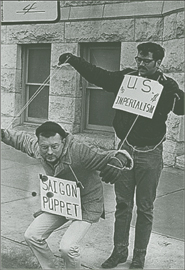
Originally in the early 1960s most people accepted the government’s claim that U.S. troops were in South Vietnam to stop the spread of Communism. But as the years passed, America did not seem to be gaining ground even though an increasing number of troops were sent to South Vietnam. By 1968 many people from all walks of life began to question why the United States was involved.

Antiwar protestors demonstrating in Wichita, Kansas.
Those opposing the war ran the gamut from Students for a Democratic Society (SDS), to far-right conservative groups, to nonpartisan organizations, to civil rights groups. Their motives were equally diverse. College students subject to military service became draft resisters. Religious groups, such as the Quakers, protested for religious reasons. Some civil-rights groups saw the money spent on the war as being taken from money needed to fight the war on poverty and inequality. Civil rights leader Dr. Martin Luther King Jr., who had won the Nobel Peace Prize in 1964, said in a speech in 1967, “[W]e have been repeatedly faced with the cruel irony of watching Negro and white boys on TV screens as they kill and die together for a nation that has been unable to seat them together in the same schools.”
In 1965 a poll showed more than half of Americans supported the war. In 1967 polls showed that only thirty-five percent of the American people supported it. Responding to this shift, senators and members of Congress who supported President Johnson began speaking out, questioning the strategic necessity of the war.
But the true shift in sentiment was due to the fact that President Johnson had never fully communicated to the American people why it was important to be in South Vietnam. This failure, coupled with the lack of perceived success and the growing number of dead soldiers, caused more and more people of all ages and backgrounds to raise their voices against the war. This antiwar movement would come to include the nonpartisan organization Vietnam Veterans Against the War. Though never gathered into one overall group and having different motivations, these protestors—students and blue-collar workers, veterans and businesspeople—were united in their desire to end the war.
When Richard Nixon was elected president in 1968, his priority was to find a way to get the United States out of South Vietnam.